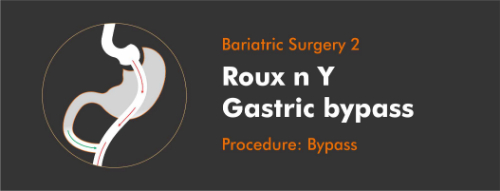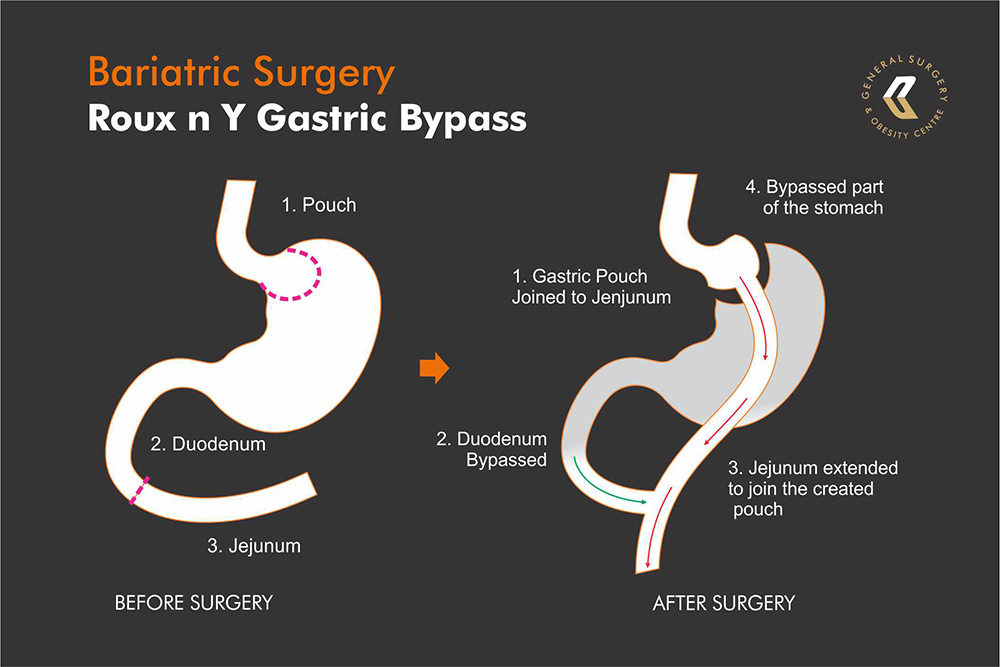
What is Roux n y Gastric Bypass?
Also known as
Gastric Bypass
Background of Roux n Y Gasric Bypass?
Who is a suitable candidate for Roux n Y Gasric Bypass?
- Patients should have a Body Mass Index (BMI) of above 40. In order for patients to be considered for Roux n Y Gasric Bypass.
- Patients who suffer from obesity related conditions such as
- Sleep apnea
- Fatty liver disease
- Type 2 diabetes
- Hypertension
- Severe Acid Reflux or GERD
- Slower Metabolism
- “Sweet Tooth”
- Barrett’s Esophagus
- Eating Disorders such Bulimia or Binge eating
- Patients committed to creating a healthier lifestyle in preparation and after surgery to ensure the best possible results.
How much weight can I lose with the Roux n Y Gastric Bypass?

How is the Roux n Y Gastric Bypass Performed?
What are the benefits of Roux n Y Gastric Bypass?
- You should anticipate to lose roughly 30% of your pre-surgery body weight after treatment.
- You’ll have more energy and be able to move about more freely. Have less health issues as a result of weight loss.
- Reduction of conditions associated with obesity such as, type 2 diabetes, fatty liver disease, sleep apnea and other morbid conditions are greatly reduced
- Lower-back pain and joint pain are typically relieved or improved in nearly all patients.
What to expect after Roux n Y Gastric Bypass?
Patients may experience tthe following symtoms after surgery
- Scratchy sore throat
- Uterine cramping
- Shoulder pain from the gas used during the laparoscopy
- Feeling bloated or nausea
- Vaginal bleeding (or discharge like a menses)
It may be advised to avoid intercourse, baths, douching, strenuous exercise or heavy lifting for 4-6 weeks after the operation.
Roux n Y Gastric Bypass normal recovery times
Walking exercises and raising the legs when seated are important. These light activities will reduce the chance of blood clots.
Roux n Y Gastric Bypass lifestyle changes
Bariatric surgery improves your physical quality of life as you become more flexible. It will help you
- regain independence,
- improve breathing,
- increase energy and stamina,
- and relieve joint pain caused by obesity.
Exercise will become faster and easier as the excess weight is lost, build stamina and discover cardiovascular fitness.
Roux n Y Gastric Bypass post treatment diet
Individuals must avoid malnutrition after a gastrectomy by eating sufficient protein every day.
Patients should take supplements, vitamins and minerals to avoid deficiencies. Supplements should either be in a liquid, under-the-tongue or a chewable form right after surgery
Risk factors One Anastomosis
- heavy bleeding
- infection
- blood clots formed in the legs
- side effects of anesthesia
- lung or breathing problems.
Risks associated with Roux n Y Gastric Bypass
- Leakage represent the most common complication
- Bleeding is the second most common risk factor, this occurs at the stapled lining along the gastric pouch
- Dumping syndrome,when food is consumed too quickly, this can be be corrected through an correct eating habits
- Blood clots
- Nausea
- Serious acid reflux
- Dilation of esophagus.
- Inability to eat certain foods.
- Obstruction of the stomach.

